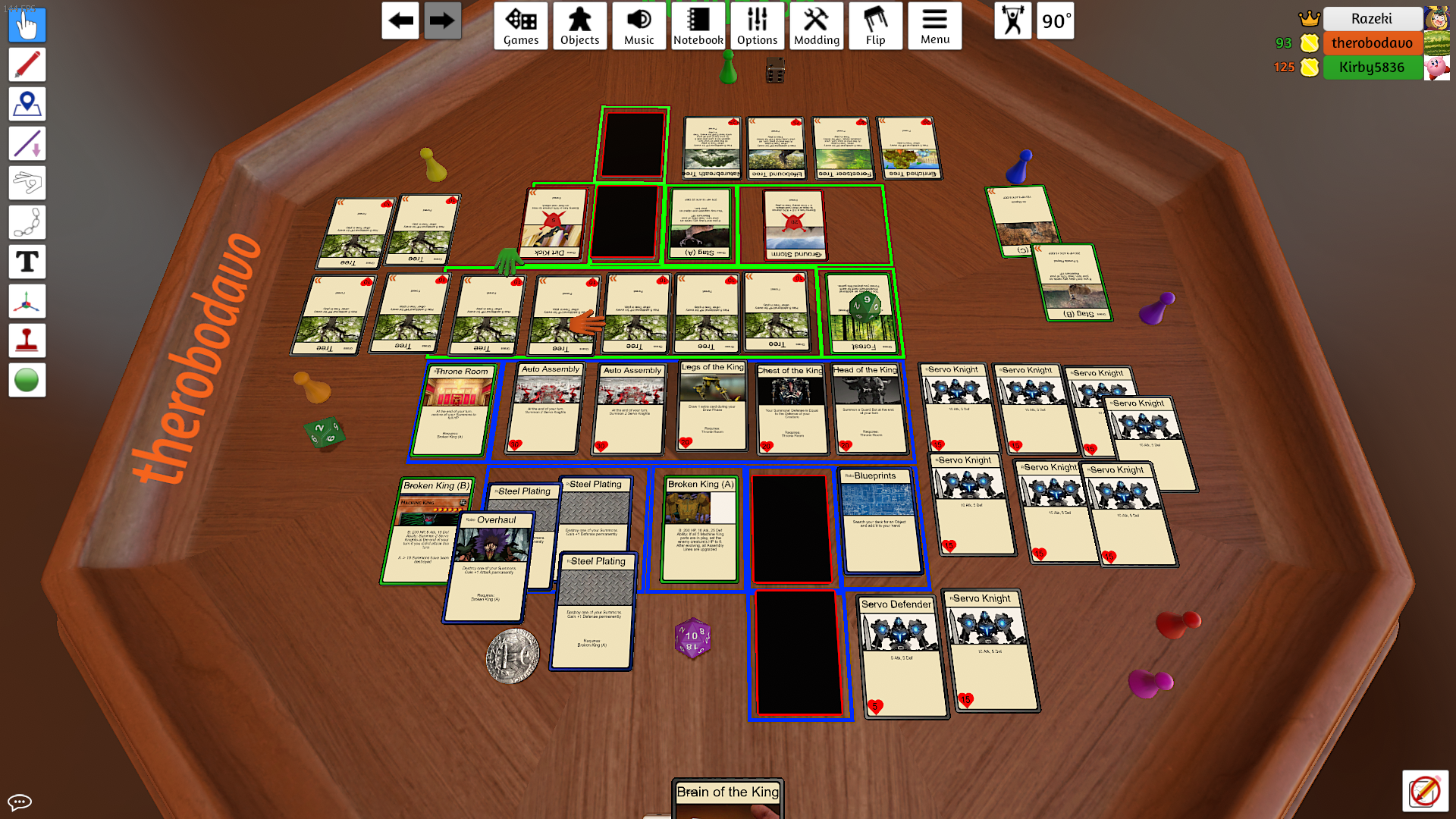Making the Roadmap
Hey guys! David L. here this time. Nate’s written a LOT of our development progress within the last three posts, so he’ll be spending more time on other work now. We’ve had another productive day of playtesting our game, where my deck got absolutely destroyed by David K.’s deck…but that’s intentional! We’ll continue developing our cards to be more balanced over the next few weeks. So here’s what we learned and what our plan is going forward!
Defining Deck Archetypes
Last post, Nate had shared the weaknesses and strengths each of our decks had. David K. and I had spent our time refining our decks to make sure that our archetypes can still work as we planned, while Nate explored a new deck archetype that focused on Summons.
Nate and I went first with battling our decks against each other. The board was flooded with Objects and Summons through the whole game!

Though the Broken King had an entire army of Servo Knights at his side, they weren’t enough to stop the power of the Trees… This was a very insightful playtest, because it helped us get a feel about how slow-building decks would interact with each other. We were able to take away from this that:
- The Grass Deck starts weak, but hits hard if it reaches very late game. This successfully fits the intended archetype.
- The Robo Deck can sustain well and overwhelm the board with Summons, if not dealt with. This also fits the intended archetype. But most importantly…
- The player feels more powerful with being able to build more entities onto the field.
That is the money-making goal we desired in our game. We want the player to feel this rush of power as they pull of cool tricks with their decks. It’s fun to be able to have that feeling of increasing strength as the game goes on!
Afterwards, David K. and I had our round of sparring. Fire against Grass! Who will win?
Well…fire, duh. David K.’s deck stomped mine into the ground, since his focuses on a much more aggressive archetype, as opposed to my deck focusing on a “survive” playstyle. After the quick match between us, we then had another, but this time we played the other person’s deck. We did this to get a feel about how the opposite kind of archetype would play. ( No picture this time, sorry! :( )
Fire crushed Grass again, but this time we were able to help each other figure out what may need to be changed.
- The Fire Deck jumps too quickly in strength. We can keep the quick jumps of strength, but make it less of a power gain than other creatures.
- The Grass Deck lacks the ability to do anything against aggression. Though these kinds of decks are not meant to win over aggression, it still feels frustrating when playing against them. We need to find a way of making it so the Grass Deck still has a fighting chance.
A lot of these changes come down to balancing out the values, so there will be lots of playtesting still ahead of us.
But there was also something we all found to be a problem in the game.
A Missing Piece
During every one of our games, we often decided to not attack Objects or Summons. It just never felt worth it. It’s rather hard to pinpoint the reason as to why, since we each had our own theories.
- The Objects have too much HP.
- The Attacks are never worth using on an Object/Summon over the Creature.
- It takes too much resources to destroy an Object.
All of these could be valid reasons, so we discussed and decided that this will be our next plan of action to solve. We will be changing parts of the system until we find a resolution to this problem. While we were on the topic of discussing the next course of action, we also went more into what we want done before we begin developing this game in engine.
The Roadmap
We sat down and thought a lot about what we absolutely need to have done before beginning development. We want to have the prototype completely developed with this system before implementing it into engine, so that we will know for sure that this is still a good idea going forward. Here’s our list for what needs to be done:
- Solution for attacking Objects/Summons
- Define and standardize depth of mechanics
- Develop a full list of cards
- Balancing
- External playtesting
- Write design document
We will be tackling each of these in order, and possibly adding more to this list with new problems that may arise. But for now, we have created a concrete list of tasks that must be done before development. Our plan and game is starting to really take shape now!
That’s all for this update. The Stag is in the bag.
Stay safe and see you next time! - David Liu